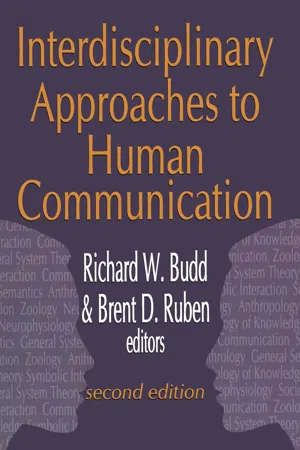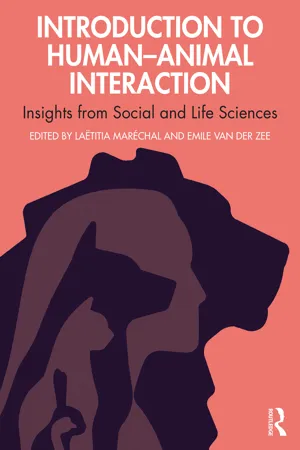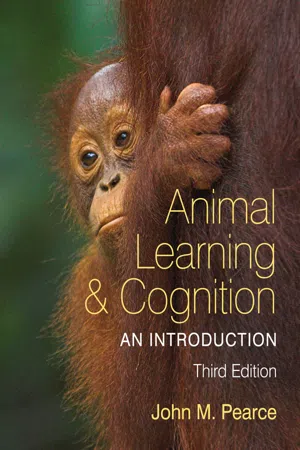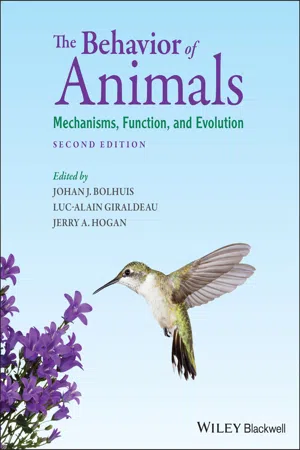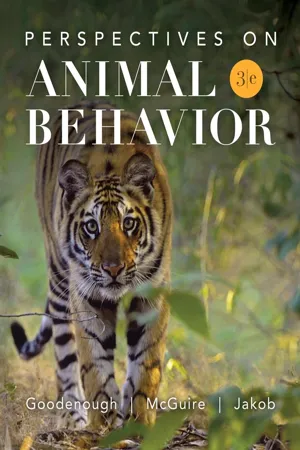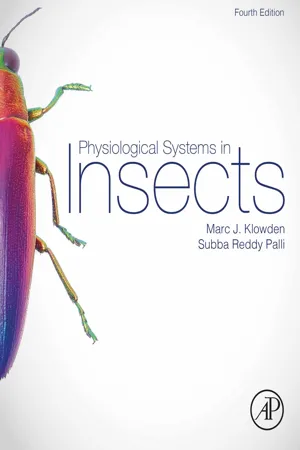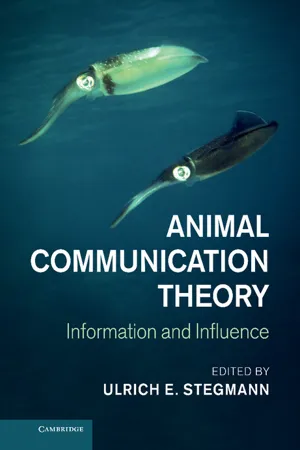Biological Sciences
Animal Communication
Animal communication refers to the transmission of information between animals using signals such as sounds, visual displays, or chemical cues. This communication serves various purposes, including mating, warning of danger, and establishing social hierarchies. It plays a crucial role in the survival and reproduction of individuals and the maintenance of social structures within animal populations.
Written by Perlego with AI-assistance
Related key terms
1 of 5
12 Key excerpts on "Animal Communication"
- Brent D. Ruben(Author)
- 2018(Publication Date)
- Routledge(Publisher)
2Zoology Hubert FringsDefinitions and Problems
AN exact definition of Animal Communication is not possible—indeed, may never be possible.(7 ; 12 , pp. 5-18 ; 26 ) It is generally agreed, however, that an operant definition can be formulated. Communication between two animals is said to occur when one animal produces a chemical or physical change in the environment (signal ) that influences the behavior of another. The study of Animal Communication has received no generally accepted single name, being engaged in by students in many fields: sensory and nervous physiology, ecology, animal behavior (ethology), and comparative psychology. Sebeok(24 ; 26 ) has suggested the term zoosemiotics for this field of research, but it is still too early to see whether this will be adopted generally.While some students of animal behavior would restrict communication to intraspecific relationships only, others would include any case in which the behavior of one animal influences that of another, thus including warning colors, and the like. An interesting case in point is that of echolocation: the ability of some animals—for example, bats and porpoises—to locate unseen objects by reflected pulsed sounds. Some consider this a form of autocommunication; others consider it not communication at all. We shall not discuss echolocation here, not because it is unworthy of discussion or should necessarily be excluded from communication, but for the much more prosaic reason that there are enough other matters to occupy us.Up to now, studies on Animal Communication have not in themselves led to generalizations that aid our understanding of human communication. When comparisons between human and Animal Communication have been made, they have invariably been by someone trying to decide whether animals actually have languages, and the criteria used have been those proposed by students of human language (cf., for instance, Hockett in Ref. 14 and Count in Ref. 26). Studies on Animal Communication are still generally empirical and have not resulted in many theoretical concepts. As for the question of animal language, one’s view of its existence or nonexistence depends entirely upon the criteria he selects as critical, and these vary from worker to worker. Luckily the matter does not concern us practically, and studies proceed fruitfully without a decision.- eBook - ePub
Introduction to Human-Animal Interaction
Insights from Social and Life Sciences
- Laëtitia Maréchal, Emile van der Zee, Emile Zee(Authors)
- 2024(Publication Date)
- Routledge(Publisher)
3 Human–Animal Communication Emile van der Zee and Kun GuoDOI: 10.4324/9781003221753-33.1 Introduction
Human–Animal Communication is a core aspect of human–animal interaction (HAI): in any HAI information is exchanged between us and other animals. Communication not only involves speaking but also reading each other’s behaviours, body posture, facial expressions and so forth. Any prejudices in human–Animal Communication, or our theories on this, may impact on animal welfare: if we comprehend other animals’ intentions in the wrong way, their pain, their needs, their emotions and what disadvantages them, the consequences for their welfare – but also our own welfare – can be severe.This chapter describes what communication is, how humans communicate with each other, how other animals communicate with conspecifics, and how communication features compare between humans and other animals. The last part of this chapter focuses on the overlap in the biological systems of humans and dogs, as a case study on how the biological systems of humans and dogs constrain communicative interaction.Communication is the transfer of information from a signaller to a receiver. Information sent by a signaller must be meaningful or interpretable for the receiver. Communication channels vary widely: grunts, calls, songs, gestures, facial expressions, the use of colours, chemicals (e.g. pheromones), touch and so on. Intention or conscious processing is not necessary for communication to take place. For example, plants can signal the presence of predation to each other: damaged sugar maple seedlings and corn can emit airborne substances to signal damage, making it possible for other plants to become less palatable (van der Zee & Weary, 2010 ). Producing meaningful signals comes at a cost, however: there is an energy investment for the signaller, and signalling may make the signaller more vulnerable. Signallers have many ways to offset those costs: it may give them a reproductive advantage, it may give those genetically close to them an advantage in outcompeting others, or signallers may communicate messages that are not truthful and this therefore gives them a resource advantage. For example, subordinate tufted capuchin monkeys give more alarm calls signalling the presence of predators (felids, aerial predators and snakes) when dominant conspecifics are around, making it possible for these subordinates to have better access to a food source (Wheeler, 2009 - eBook - ePub
Animal Learning and Cognition
An Introduction
- John M. Pearce(Author)
- 2013(Publication Date)
- Psychology Press(Publisher)
Animal Communication and language
DOI: 10.4324/9781315782911-13- Animal Communication
- Communication and Language
- Can an Ape Create a Sentence?
- Language Training with Other Species
- The Requirements for Learning a Language
Defining precisely what is meant by Animal Communication is a surprisingly difficult task that can readily lead to controversy. For present purposes, however, a useful definition is that communication occurs when one organism transmits a signal that another organism is capable of responding to appropriately. By interpreting this statement loosely, a wide range of species can be said to communicate. One of the simplest creatures, the protozoan, can influence the movement of others by secreting a chemical; during courtship, the male fruit-fly stimulates the female by producing a sound with its wings; and the chimpanzee uses a range of sounds, facial expressions, and smell to influence the behavior of other members of its social group.The fact that animals are able to communicate with each other raises a variety of related questions. What sort of information do they communicate? How does the ability to communicate develop? Does one animal communicate with the intention of influencing another’s behavior, or is the act of communication little more than a response to a certain stimulus? The purpose of the first part of this chapter is to address these questions by focusing on selected examples of communication by different species.Other questions that are inevitably raised in discussions of Animal Communication concern their ability to use language. For example, to what extent does Animal Communication resemble language, and can animals be taught a language? The most important intellectual capacity possessed by humans is language. By use of the spoken word we are able to live together in large and more or less harmonious social groups; we can teach our children an enormous range of skills; and we can also express our feelings and our thoughts. By use of the written word we have benefited from the knowledge acquired by others over a period of more than 2500 years. The written word can also be used to create great works of art. Some have argued that language is unique to humans and that without it our lives would be little different to those of other animals (e.g. Chomsky, 1957 ; Macphail, 1982 ; Pinker, 1994 - eBook - ePub
- Nicky Hayes(Author)
- 2014(Publication Date)
- Psychology Press(Publisher)
Communication and information 5The ability to receive information and to transmit it to the outside world also provides animals with the mechanisms of communication. But what is communication? Defining what we mean by communication isn't very easy, not only because communication can take so many forms, but also because it may be entirely unintentional on the part of the communicator. If a bird sings to advertise its ownership of territory to other potential rivals, but also incidentally informs a prowling cat of its whereabouts, has it communicated with the cat? The simplest definition of communication, that it involves information passing from one animal to another, would imply that it has.Some researchers, however, take a different view. Slater (1983) argued that an essential feature of communication is that the receiver should benefit from it, at least on average. In evolutionary terms, Slater argued, communication has evolved because it contributes somehow to the animal's inclusive fitness . That doesn't mean that it always benefits the animal—as just described, there may be occasions where it is disadvantageous to a particular individual on a particular occasion. But on average, it will be more of an evolutionary advantage to the animal than not communicating would be.Another view of communication focuses on the effect that the communication has on the recipient. Krebs and Davies (1978) argued that the reason why communication benefits the animal that is sending the information is because it allows that animal to influence, or manipulate, the behaviour of the animal that receives it. This manipulation of others confers an evolutionary advantage on the sender. The bird sings because the behaviour of its potential rivals is different as a result of its singing.Marler (1984) argued that communication is a much more interactive process than either of these two models suggest. Both sender and receiver, Marler argued, benefit from an act of communication: the important element in communication is that it is mutual, and involves both of them. To the bird singing the song, there is an advantage in sending information because that influences the behaviour of potential rivals; but there is also an advantage to the receiver of the message, because it can use that information to maximise its own survival as well. It is the transaction - eBook - PDF
The Behavior of Animals
Mechanisms, Function, and Evolution
- Johan J. Bolhuis, Luc-Alain Giraldeau, Jerry A. Hogan, Johan J. Bolhuis, Luc-Alain Giraldeau, Jerry A. Hogan(Authors)
- 2021(Publication Date)
- Wiley-Blackwell(Publisher)
A second focus will be the relationship between Animal Communication and human language. Human language is far more complex and cognitively sophisti-cated than the communication system of any non-human animal. Nonethe-less we still can ask about specific ways in which human language is more advanced than Animal Communication, and about the nature of commonal-ities between the two. Before we get to any of these questions, however, we define communication and its relationship to information. I N T R O D U C T I O N 368 william a. searcy and stephen nowicki Communication and Information C ommunication can be defined as the production of acts or structures that affect the behavior of other individuals and that have evolved because of those effects (Wheeler et al. 2011). Such acts or structures are termed signals . The first part of this definition specifies that communication is considered to occur only if the signals produced by one individual influence the behavior of another. This influence can be overt and immediate or subtle and delayed. The second part of the definition spec-ifies that communication involves signals that have evolved because of their effects on others. Acts or structures that affect other individuals but have not evolved because of those effects are termed cues rather than signals, and their production is not considered communication. An example of a cue is the compound 4-methylphenol, which is found in human sweat, and which has the effect of attracting Anopheles mosquitos (Hallem 2004). Attraction of Anopheles mosquitos (the vector for malaria) cannot be selectively advantageous for humans, so we cannot have evolved production of 4-methylphenol for that purpose. 4-methylphenol is therefore a cue and not a signal, and humans are not considered to be communicating to mosquitos when they produce this chemical. Some definitions of communication add the requirement that information must be transferred for communication to occur. - eBook - PDF
- Judith Goodenough, Betty McGuire, Elizabeth Jakob(Authors)
- 2015(Publication Date)
- Wiley(Publisher)
(2007) identified four chemicals released by the dancers. When the researchers injected these chemicals into the air inside the hive, more foragers exited the hive. Thus, it seems that these chemicals cause the bees to become primed to look for food. SUMMARY Different definitions of communication have been used in the literature. Here, we will use the definition that com- munication occurs when information is transferred from the sender to the receiver and that the sender ben- efits, on average. A behavior, such as a call, or a feature, such as a colorful feathered crest, that transmits infor- mation is called a signal. Signals are thus distinct from cues, which may provide information to another animal but do not benefit the sender, such as the rustle of leaves that attracts an owl to a mouse. Any sensory channel may be used for communication. Signals within each channel have characteristic properties that make them more or less useful, depending on the species, the environment, and the function of the signal. Visual signals are easy to locate, are transmitted quickly, and disappear just as fast. However, visual sig- nals must be seen and are, therefore, useful only when there is enough light and where there are few obstacles to obscure them. Visual signals include color and pattern, as well as movements and postures. Auditory signals can be transmitted over long dis- tances. The rate of transmission and fade-out is rapid. They do not require light and, in fact, work well under water. The sounds may be generated by respiratory structures, the rubbing of appendages, or beating on parts of the environment. Some animals produce sounds above (ultrasound) or below (infrasound) the limits of human hearing. Seismic signals are those caused by vibration of the environment. They are well suited to communication over long distances. Seismic signals can be produced when an airborne vocalization couples with the ground. - eBook - ePub
Questions About Language
What Everyone Should Know About Language in the 21st Century
- Laurie Bauer, Andreea S. Calude, Laurie Bauer, Andreea S. Calude(Authors)
- 2020(Publication Date)
- Routledge(Publisher)
Aechmophorus occidentalis ). Importantly, most of these convey essentially the same rather simple message: advertising the availability of the individual for mating. This is of course by no means the only message an animal can communicate, but it is typical in its directness and its relation to the immediate context in which the signal is presented.Apart from visual displays, there are a number of other channels through which animals inform one another. Chemicals including pheromones and other olfactory signals (in ants, bees, moths, mice, lemurs and many others), ultrasound (in bats, dolphins and the courtship songs of mice, among others), infrasound (in elephants) and the production and perception of characteristic electric fields (in certain fish) all provide efficient signalling channels under ecologically appropriate conditions.Of course, many non-human species communicate in sound as humans do. This includes frogs, birds (who produce a variety of calls, in addition to the specialized class of vocalizations represented by true song in most of the nearly 4,000 species belonging to the order Passeriformes), as well as virtually all mammals to at least some extent. Birdsong is a particularly interesting and complex form of vocal signalling, of which more will be said below. However, despite a number of distinctive characteristics, the songs of birds are in the end no different in their essential character from other animal signals. The song is an assertion of the bird’s possession of a territory, for the purpose of defending it against competitors and attracting potential mates. No matter how internally complex, that complexity is never linked to a more complex message.Compared with the lexicon of a human language, the inventories of available signals in animal systems are several orders of magnitude smaller. Abstracting away from varying degrees of the intensity with which a communicative display is produced, the characteristic repertoire of any given species is quite limited. A sensitive observer will generally find a number of distinguishable signals, but that number is still typically quite limited: fewer than 40 in any species that has been seriously studied. - eBook - ePub
- Marc J. Klowden, Subba Reddy Palli, Subba Reddy Pallai(Authors)
- 2022(Publication Date)
- Academic Press(Publisher)
Many definitions of communication have been proposed, but none has been completely satisfactory to everyone. Animals produce many signals, not all of which are considered to be communications. Some definitions require that the interchange between two individuals must be in some sort of code whose structure has been forged through the process of natural selection in order for the signals that are produced to be classified as a communication. The reception and interpretation of this code, whether visual, auditory, or chemical, must be mutually beneficial by this criterion and result in the increased fitness of the participants. However, insect communication will be considered here in its broadest sense; if one individual gives off any signal that produces a change in the behavior of another individual, it will be considered to have been a communication. This chapter will review some of the ways that insects produce these signals.One way to classify the systems of communication is according to the receptors that are involved in receiving the stimuli. We can identify various chemical, tactile, acoustical, and visual signals as being the primary means of communication in insects, each with its own advantages and disadvantages (Fig. 12.1 ). The reliance of a species on one signal over another is primarily a function of the ecological context in which the insect must function. For example, with the exception of those species that produce their own light, insects that are active at night are generally less dependent on visual cues for communication. Although signaling systems will be described individually, it must be emphasized that the expression of a behavior in natural situations often requires the involvement of signals using several sensory modalities. For example, tactile communication often elicits behavioral changes only in conjunction with other visual and chemical cues.Fig. 12.1 The characteristics of some signals used in insect communication. From Case, J.F., 1984. Vision in mating behaviour of fireflies. In: Lewis, T. (Ed.), Insect Communication. Academic Press, London, pp. 195–222. Reprinted with permission. - eBook - PDF
- Timo Maran, Dario Martinelli, Aleksei Turovski, Timo Maran, Dario Martinelli, Aleksei Turovski(Authors)
- 2011(Publication Date)
- De Gruyter Mouton(Publisher)
Without doubt, the vast majority of these interspecific signals arise in connection with competition, predation, parasitism, or mutual symbiosis. Here one encounters the less clearly defined topics of sham, mimicry, and interspe-cific territoriality. If a signal travels from one member of a species to another, the question of sexual function arises. Does a signal evoke aggressive or attractive behavior in the recipient or does it aid in maintaining a hierarchy prior to mating activity? By considering the behavioral pattern together with the origin and destination of the signal(s) responsible for evoking it, a clear relationship emerges. If, on the other hand, a signal travels between two or more members of a species and does not exhibit an obvious sexual connotation, one suspects a more subtle social function. Basically, this may involve relatively simple social sig-nals, such as alarm or distress calls, or more structured signals functioning in aggregation, familial relationships, or colony organization. The Study of Animal Communication: An Overview 115 The third category, that in which signals pass from the environment to the animal, includes those signals which result in regulation of behavior with re-spect to physical parameters. These signals generally effect what the animal does while it relates to its environment. Included herein would be those en-vironmental signals which influence the metabolism of animals and later their behavior—examples of these effects include temperature regulation and biolog-ical rhythms. Also in this category would be the familiar studies of navigation, migration, homing, and echolocation. Table 1 summarizes this entire complex of animal behavior, organized ac-cording to the origin and destination of signals. Separation of this pattern into two columns provides for the possibility of shifting different behavioral cate-gories within the second column without the need for changing the basic outline shown in the first column. - eBook - PDF
Animal Communication Theory
Information and Influence
- Ulrich E. Stegmann(Author)
- 2013(Publication Date)
- Cambridge University Press(Publisher)
I thank an anonymous referee for raising this issue. 78 Andrea Scarantino the transmission of information to claims about how things turn out to be (Scarantino & Piccinini, 2010). I conclude that any extensionally adequate and scientifically fruitful defini- tion of Animal Communication should conceptualise signalling as a specialised, information-mediated form of influencing. A systematic discussion of how a definition of this sort should be formulated, and a consideration of possible objections to it, will have to wait for another paper. 2.6 Conclusion Information-based accounts have suggested that the evolutionary point of signalling is to transfer information. Influence theorists have rejected this view, arguing that the point of signalling must be to influence other organisms to one’s advantage. However, they have assumed that it is possible to define signals in an information-free fashion, using only the notions of influence and selection. I have argued that even the most sophisticated information-free influence-based definition currently on offer faces significant counterexamples. The way to address them, I concluded, is not to fine-tune information-free accounts, but rather to conceptualise signals as acts or structures specialised for influencing by means of information transfer. This proposal combines information-based and influence-based approaches, which differ more in empha- sis than in substance. Bringing both information and influence to the foreground in the definition of Animal Communication will allow us to combine the insights of the two research programmes into a theoretically richer hybrid. References Bradbury, J. W. & Vehrencamp, S. L. (1998). Principles of Animal Communication. Sunderland, MA: Sinauer. Carnap, R. (1950). Logical Foundations of Probability. Chicago, IL: University of Chicago Press. Dawkins, R. (1976). The Selfish Gene. Oxford: Oxford University Press. - eBook - PDF
Language Files
Materials for an Introduction to Language and Linguistics, 13th Edition
- Department of Linguistics(Author)
- 2022(Publication Date)
- Ohio State University Press(Publisher)
Some animals communicate using visual cues. For example, dogs and apes use certain facial expressions and body postures to express submission, threat, playing, desire, and so Animal Communication 586 on. Female rabbits use the white of their tail as a flag to lead their young to the safety of their burrows. Fireflies find mates by producing light, male spiders use elaborate gestures to inform a female that they are healthy and capable of mating, and fiddler crabs wave their claws to communicate. Animals may also use touch to communicate. Monkeys hug, big cats and rhinos nuzzle each other, and bees use touch to communicate the location of a food source. Other animals use odor to communicate. The best-known example of this kind of chem- ical communication is the pheromones used by many insects to attract mates. In addition, ants use scent trails in order to communicate which path other ants in the colony should travel along. Some fish and amphibians use electrical signals to communicate. These are often used to identify mates, broadcast territoriality, and regulate schooling behavior. Unlike sound, electrical signals don’t get distorted when passing through different materials, for example, murky water. Semanticity and Pragmatic Function, respectively, refer to the fact that signals in all communication systems have meaning and that all communication systems serve some useful purpose. The previous paragraphs have already mentioned many of the meanings conveyed by Animal Communication systems. Since survival is the key function of Animal Communication systems, the meanings of signals usually have to do with eating, mating, and other vital behaviors, such as deciding to fight or flee. In all of the previously men- tioned examples, such as bees communicating the location of a food source and dogs and apes communicating submission or threat, the messages being communicated have clear purposes: helping others find food, and warning others of danger. - Richard Joyce(Author)
- 2017(Publication Date)
- Routledge(Publisher)
Nucleic Acids Research 28: 2794–2799.Seyfarth, R. & Cheney, D. 2003. “Signalers and receivers in Animal Communication.” Annual Review of Psychology 54: 145–173.Shannon, C. 1948. “A mathematical theory of communication.” Bell System Technical Journal 27: 379–423, 623–656.Shea, N. 2007. “Consumers need information: Supplementing teleosemantics with an input condition.” Philosophy and Phenomenological Research 75: 404–435.Skyrms, B. 2010. Signals: Evolution, Learning, and Information (Oxford University Press).Stegmann, U. 2013. “A primer on information and influence in Animal Communication.” In U. Stegmann (ed.), Animal Communication Theory: Information and Influence (Cambridge University Press) 1–39.Stegmann, U. 2015. “Prospects for probabilistic theories of natural information.” Erkenntnis 80: 869–893.Suppes, P. 1983. “Probability and information.” Behavioral and Brain Sciences 6: 81.Williams, G. 1966. Adaptation and Natural Selection (Princeton University Press).Passage contains an image
7 The Construction of Learned Information through Selection Processes
Nir Fresco, Eva Jablonka, and Simona GinsburgIntroduction
The aim of this chapter is to offer an analysis of information in the context of learning and communication. Information has been previously analyzed in the context of phylogenetic evolution, suggesting a receiver-centered, functional notion of information (Jablonka 2002). This analysis is complemented here by addressing the question of how an individual can learn and develop during ontogeny through exchanging and processing information. To this aim, we present a broad notion of functional information
Index pages curate the most relevant extracts from our library of academic textbooks. They’ve been created using an in-house natural language model (NLM), each adding context and meaning to key research topics.
